Gary O’Neil’s approach at Wolves has introduced a refreshing tactical blueprint that’s shaping the team’s identity on the pitch. Known for his adaptability and structured game plan, O’Neil has implemented strategies that emphasize defensive resilience, quick transitions, and calculated build-up play. This tactical analysis delves into how Wolves are evolving under O’Neil’s leadership, focusing on formations, player roles, and key in-game adjustments. From intense counterpressing to well-timed counterattacks, we’ll explore the strategic elements that define Wolves’ playstyle and how O’Neil is maximizing his squad’s potential.
Build-up
Low Build-up
In the low build-up, O’neil usually sets his team up in a 4-2-5 formation. The goalkeeper moves up into the backline to create a back four, allowing the wingbacks to push higher. The six building players can work together to beat the initial press and the five attackers can cooperate to create goalscoring opportunities.
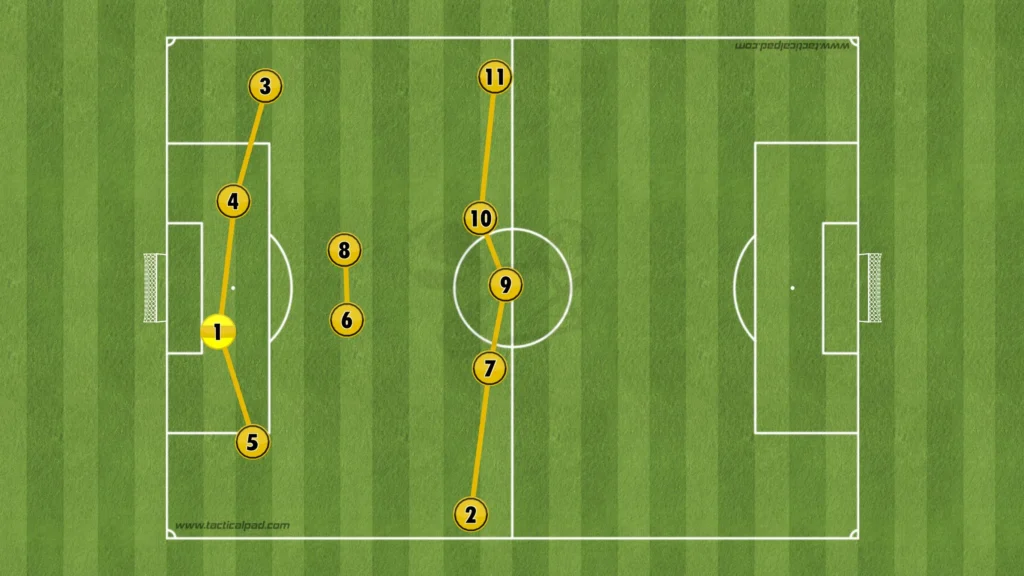
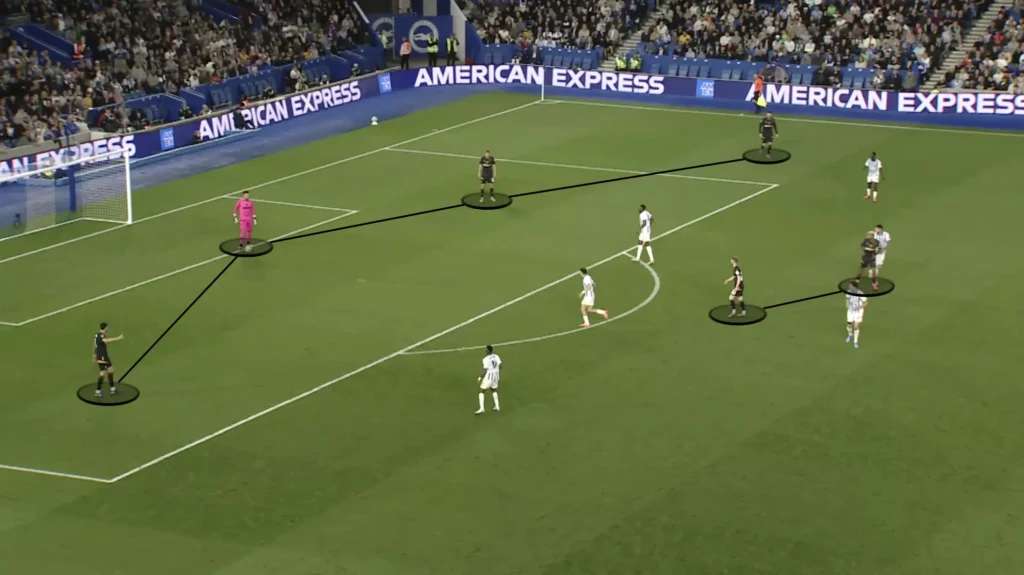
O’Neil mainly wants to beat the press by finding an attacking midfielder in the space between the opposition’s defense and midfield, who can bounce the ball to a holding midfielder, who then can progress the ball forward.
The Wolves players are also not afraid to be more direct in the low build-up. If the opposition comes up and presses man-to-man, there will be numerical equality up top with Wolves’s attackers against the opposition defenders. The goalkeeper will sometimes find an early longer ball up to the attackers, aiming to win 1v1 or 2v2 situations. The Wolves attackers have good individual quality and will often win these battles to create goalscoring opportunities.
High Build-up
In the high build-up, O’Neil’s Wolves either set up in a 1-3-2-5 formation, the same as in the low build-up without the goalkeeper between the center-backs.
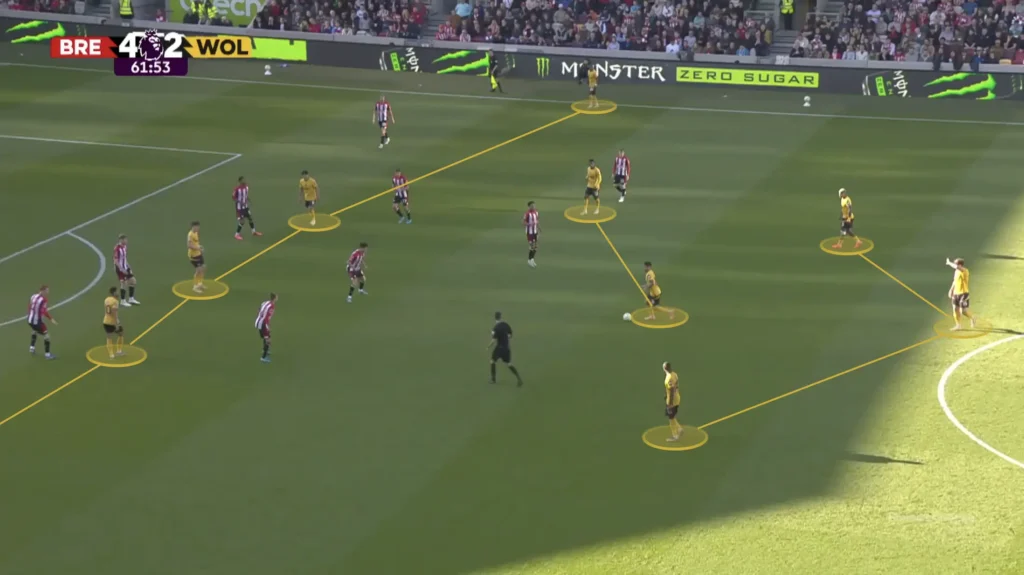
Or in a 1-3-1-5-1 formation, with one of the holding midfielders pushing up as a number-ten.
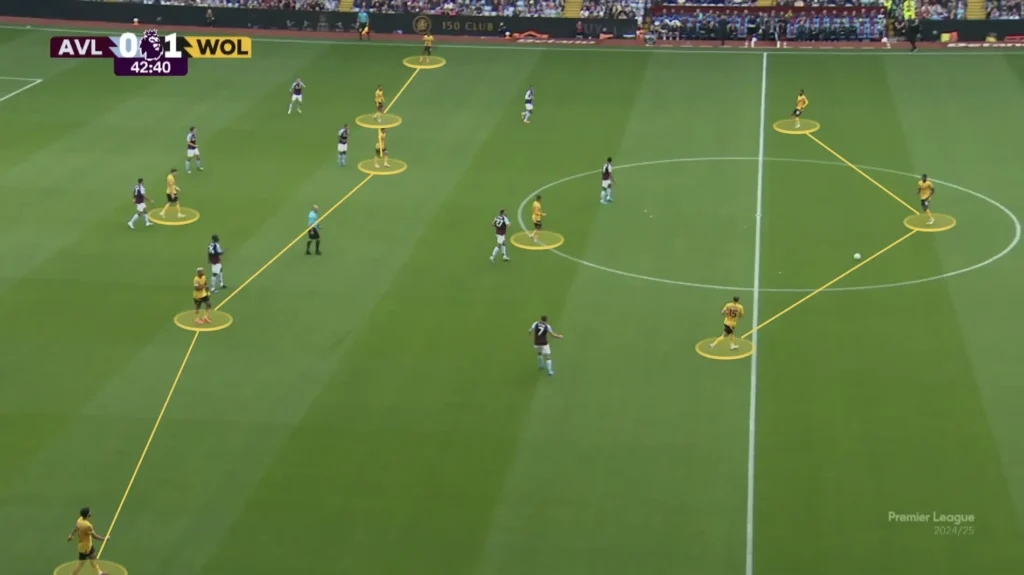
Regardless of the formation, Wolves focus on creating a numerical advantage in the midfield and stretching the opposition’s defensive lines. The three center-backs provide stability, while either one or two midfielders operate just ahead, offering passing options and support to maintain possession. The five or six players in advanced positions are spaced across the pitch, with wingbacks/wingers pushing high on either side, creating width.
This setup allows Wolves to overwhelm the opponent’s defensive structure by occupying multiple channels, forcing defenders to cover more ground and potentially leaving gaps. With an extra player in the attacking line, Wolves can create fluid, short passing combinations, with players like the attacking midfielders dropping into pockets of space to receive the ball and initiate forward plays. This high build-up structure enables Wolves to move the ball through the lines efficiently, often leading to quick attacking sequences and creating chances in the final third.
Additionally, Wolves’ attacking structure is highly adaptable, allowing players to interchange roles seamlessly depending on game situations. The wingbacks can shift into more central or advanced positions, while midfielders often drop deeper to support the backline or push forward to overload the attacking areas. This fluidity makes it difficult for the opposition to mark players tightly, as Wolves are constantly adjusting their shape to exploit spaces and maintain control.
Numerical Advantages in the Middle
Regardless of the structure, Wolves will have many players in the center. O’Neil usually has a winger/wingback wide on each side and positions the remaining eight players in the middle.
Having only two players out wide and the rest in the middle creates more options in the center and less space between the players. O’Neil likes this because he prioritizes playing through the middle. He needs one player out wide to pull the opposition apart while the rest create numerical advantages in the midfield areas.
When a team outnumbers the opposition in the midfield, it can more easily retain the ball, exploit spaces, and progress the ball through the center. Wolves will often progress the ball through quick central passes between the midfielders, beating the opposition’s press and exploiting gaps in the defense. At the same time, having many players centrally builds good conditions in defensive transitions since it allows more players to counterpress when they lose the ball.
Another purpose for keeping many players in the middle is to shorten the distance between them. This shortens the length of the passes, which naturally shortens the time between passes. This means the opposition players will have less time to push up and press, giving the Wolves players more time and control.
High Backline
A massive aspect of O’Neil’s high build-up is to have the defenders high up and close to the center. This helps in the counterpress because they get closer to the midfield. Having more players close to the center who can win the ball back makes it difficult for the opposition to do anything when they win possession. Furthermore, the high backline shortens the distance between players, shortening the time and length of the passes and preventing the opposition from pushing up their defense.
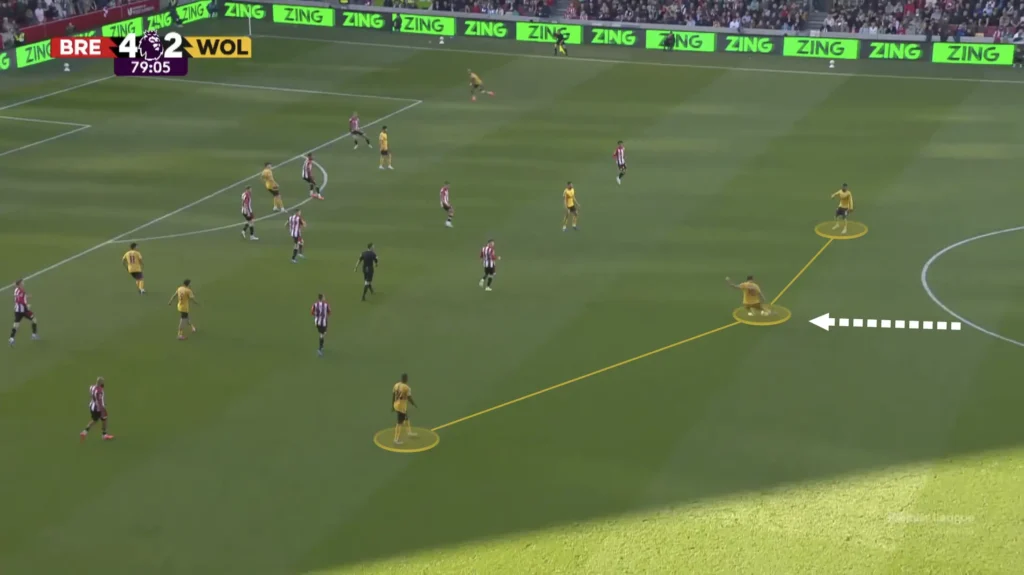
Center-backs Advancing the Ball
In the high build-up, Wolves frequently rely on their wide center-backs to advance the ball up the field, creating additional passing angles and stretching the opposition’s defensive structure. These wide center-backs push higher and slightly wider, offering more direct lines of progression along the flanks. From these advanced positions, they will often carry the ball forward themselves, drawing out opposing defenders and allowing them to play incisive passes to the wingbacks or midfielders moving into pockets of space.
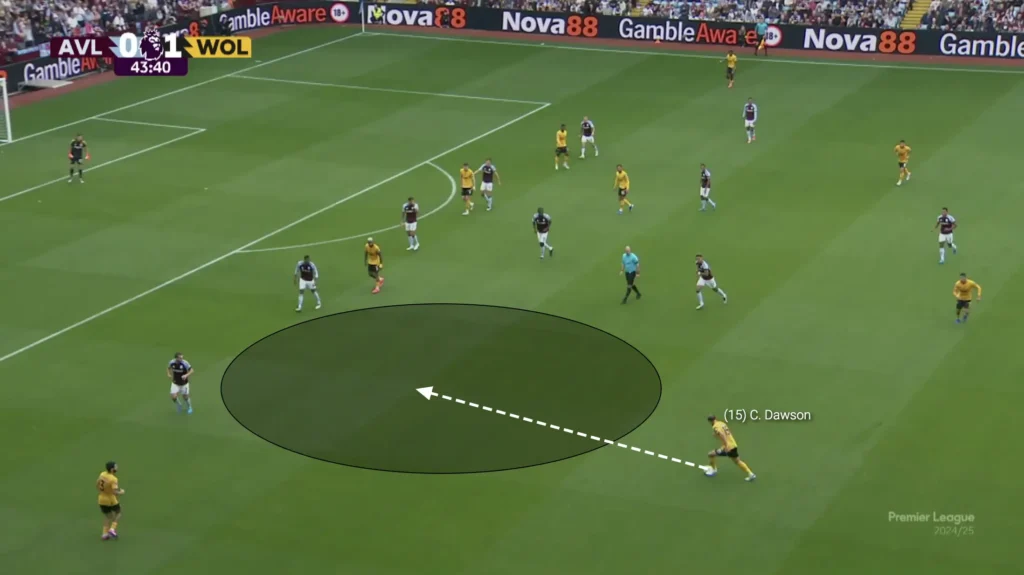
This tactic not only aids in bypassing the first line of pressure but also frees up Wolves’ midfielders to move into more advanced positions, allowing them to be ready for quick combinations in the final third. By advancing through the wide center-backs, Wolves create a fluid, dynamic build-up phase that can adapt to various defensive setups.
Finding the Pockets
O’Neil’s players always try to find the attacking midfielders in the pockets. These “pockets” refer to the spaces between the opposition’s defensive and midfield lines, where the attacking midfielders can receive the ball in more advanced positions.
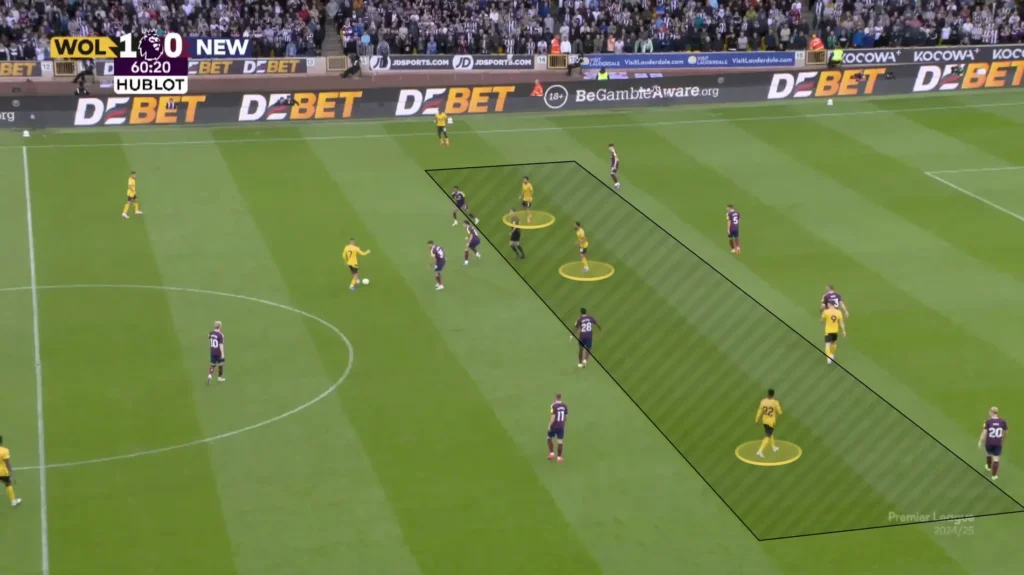
By positioning themselves intelligently in these pockets, the attacking midfielders can turn quickly and face the opposition’s goal, creating opportunities for through balls, driving runs, or direct shots. This positioning forces the opposition to make difficult decisions. If an opposition defender steps up and closes down the attacking midfielder, he potentially leaves space behind. If he stays back, he allows the attacking midfielder time on the ball. The Wolves defenders and holding midfielders will look for straight passes, breaking the opposition lines and finding the attacking midfielders who can turn and drive at the defense.
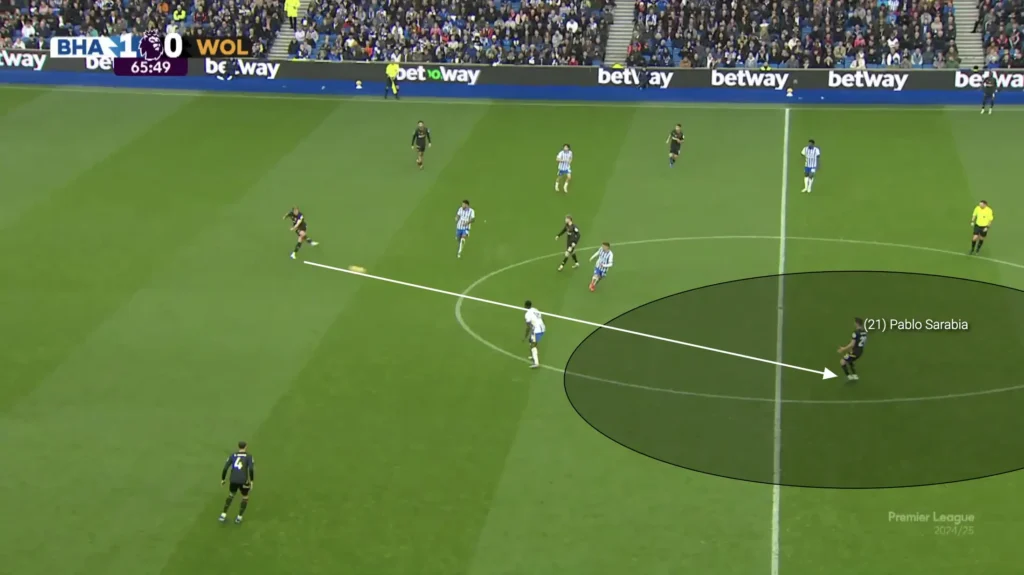
Finding these pockets is crucial for maintaining fluidity in attack and ensuring that the team can progress the ball effectively through the middle of the pitch.
When an attacking midfielder gets the ball in this space, Wolves will immediately look to attack the space behind the opposition backline. They do this with runs from the far-side attacking midfielder between the opposition’s far-side center-back and fullback. This far-side player often begins their movement just as the ball-carrier turns, making it difficult for defenders to track them. The attacking midfielder in possession then plays a direct through ball to the runner, creating dangers for the opposition.
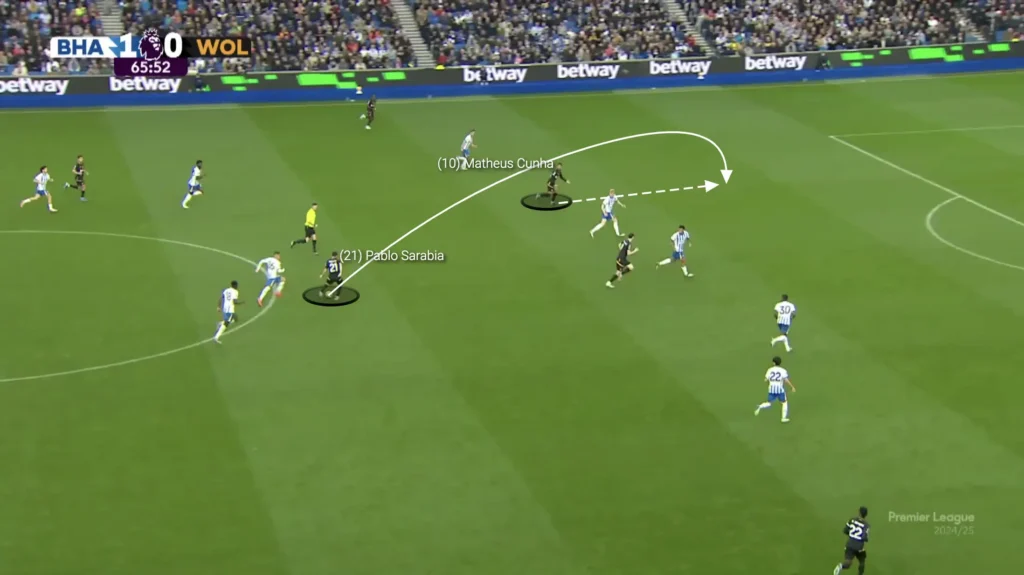
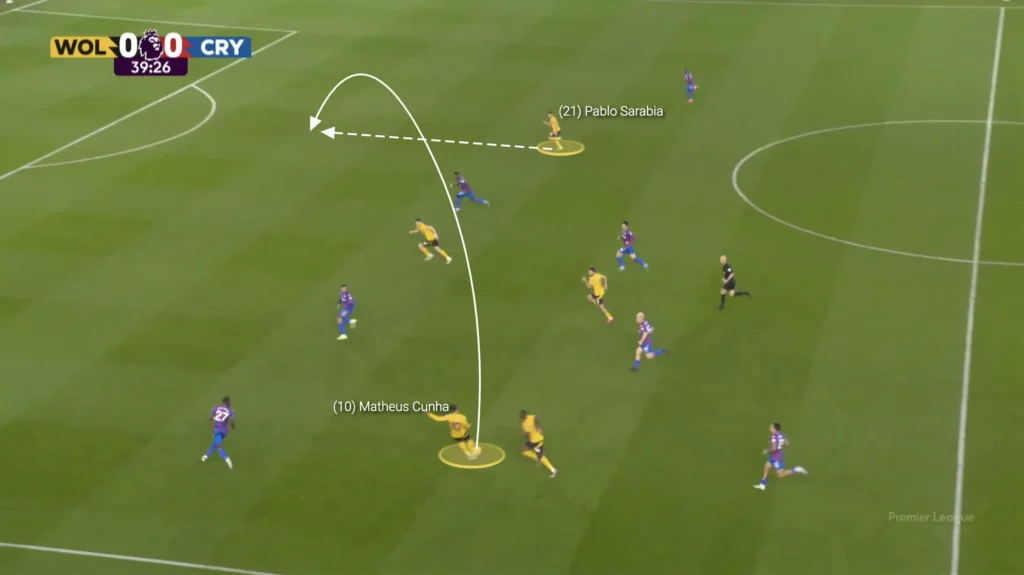
This coordinated movement stretches the defense horizontally and vertically, disrupting the opposition’s shape and creating high-quality scoring opportunities as Wolves’ attackers surge into the spaces left unmarked.
Dropping Outside
When the opposition defends very compactly and does not allow the attacking midfielders to be found in the pockets, Wolves’ attacking midfielders can drop outside to receive the ball there instead. They will wait for the opposition’s wide midfielders to come into the middle and drop out into the space outside of him. The opposition center-backs and central midfielders rarely follow these runs, not wanting to open the space in the center. Additionally, the winger, who is positioned high and wide, will be pinning the opposition fullback, not allowing him to jump on the dropping attacking midfielder. This means that the attacking midfielder can receive the ball, turn, and progress the ball unopposed.
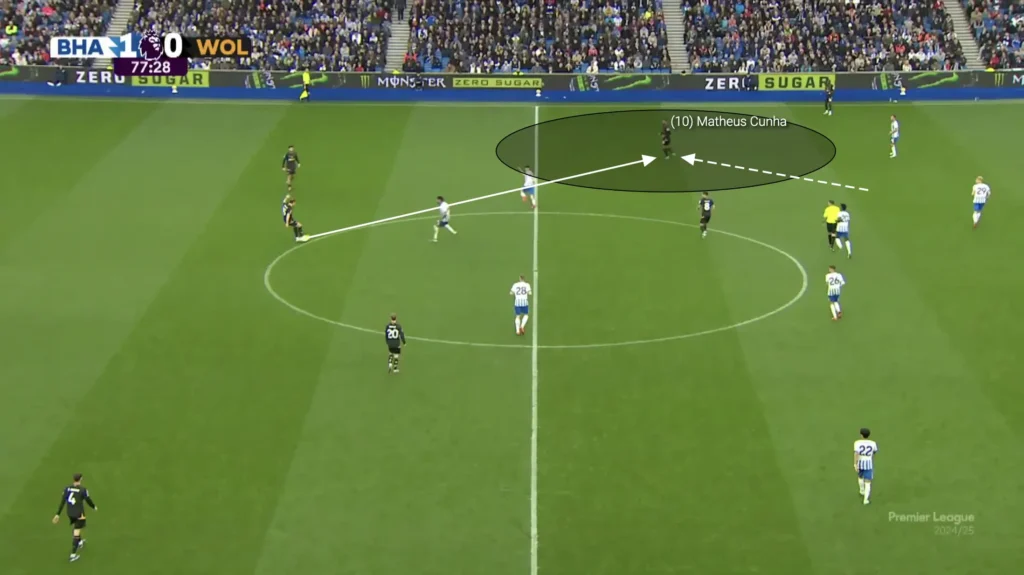
Numerical Advantages Against the Opposition’s Defense
A massive aspect of Wolves’ high build-up is their ability to create numerical advantages against the opposition’s defensive line. Playing with a front five or front six means the forward line naturally becomes numerically superior against a back four, which they are great at taking advantage of.
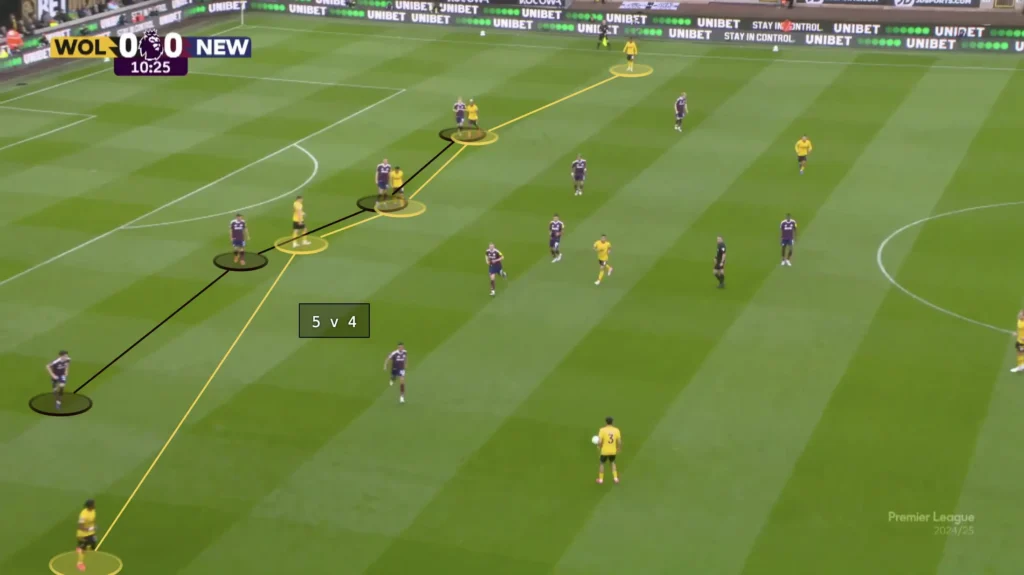
O’Neil’s players mainly exploit this overload by creating 2v1 situations against the opposition fullback. These 2v1 situations will usually be found when Wolves use quick switches of play. When the defending team is positioned on one side, the weak-side fullback becomes vulnerable to the switch of play due to the 1v2 against Wolves’ winger and attacking midfielder. The defending fullback will often come in to control the attacking midfielder, leaving space for the Wolves winger to be found out wide.
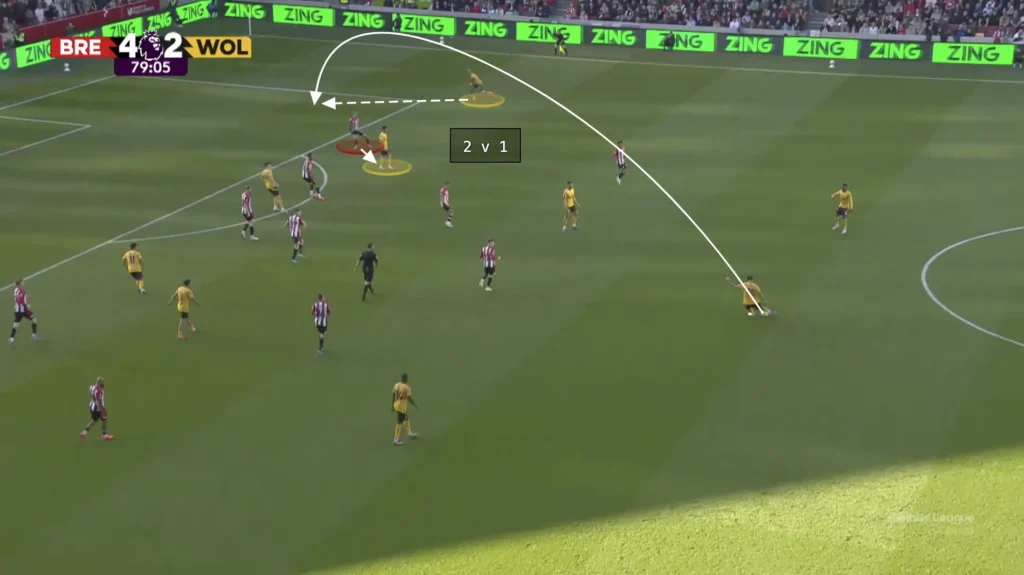
O’Neil’s team often capitalizes on this by getting the ball to the winger and creating many opportunities from 2v1 situations on the wing and in the half-spaces.
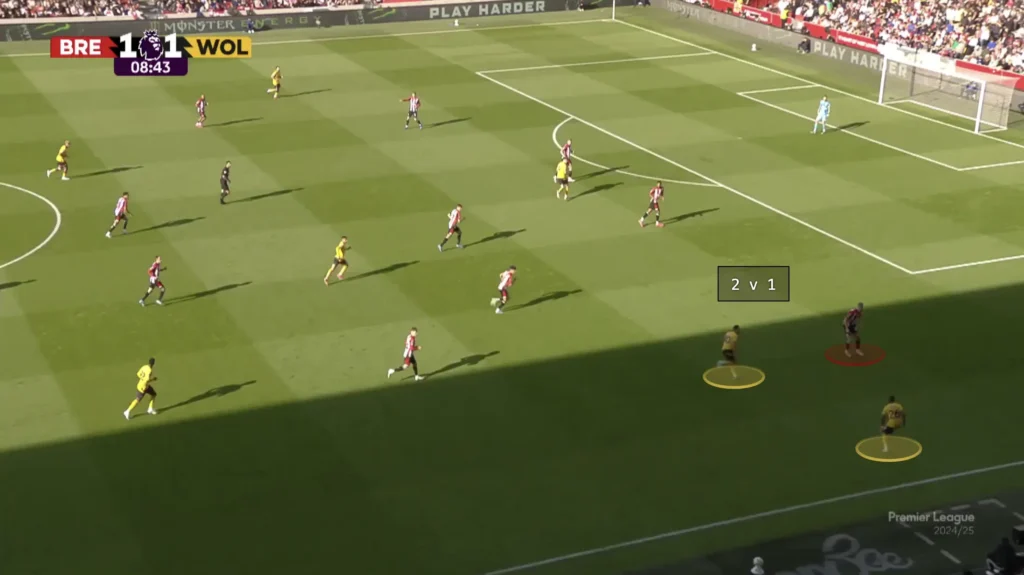
Many Players in the Box
Gary O’Neil consistently emphasizes getting multiple players into the box, creating a chaotic environment for the opposition defenders, and increasing their chances of scoring. The attackers and midfielders look to make aggressive runs into the box when the ball is in the final third, often getting four or five players into these areas to create overloads.
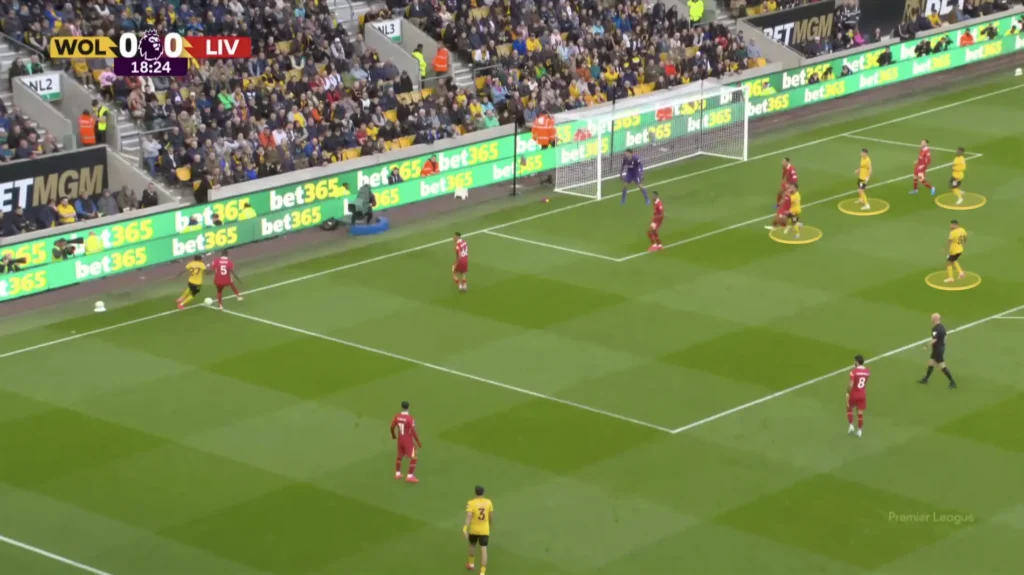
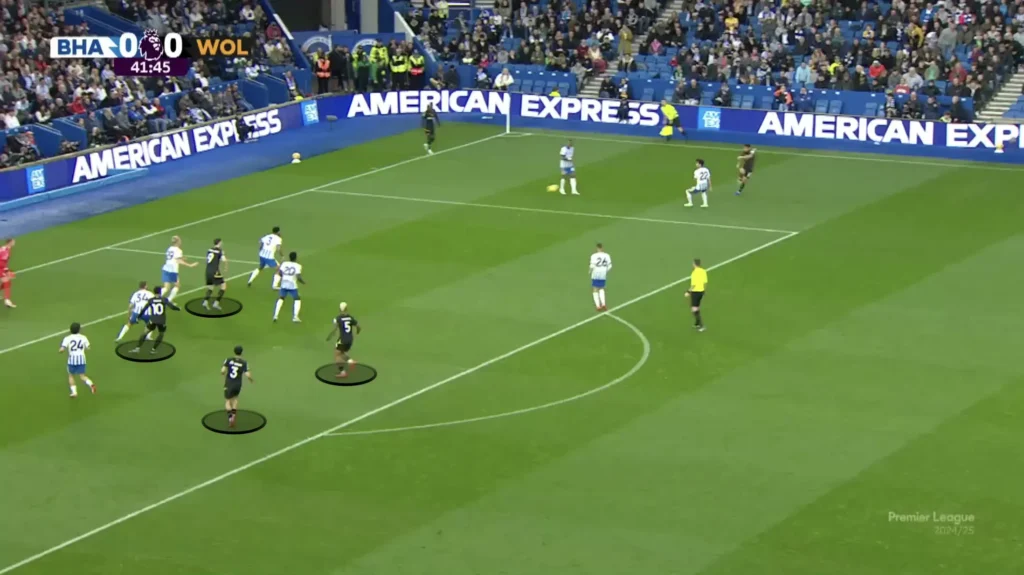
The numerical advantages in the box increase the chances of connecting with the cross, as more players present multiple targets for the crosser, making it harder for defenders to mark everyone effectively. Additionally, having multiple players in the box provides options for different types of finishes, whether it’s a header, volley, or a quick tap-in. It also allows for better positioning to react to second balls or rebounds, increasing the likelihood of capitalizing on any defensive errors.
O’Neil also positions many players outside the box, ready for the second balls and cut-backs. Wolves will often create crossing opportunities, which pushes down the opposition’s defense and opens the space in front of the opposition’s backline. The holding midfielders can collect any loose balls or be found directly in these spaces with cut-backs, and from there, they can shoot or combine with an attacker to create goalscoring opportunities.
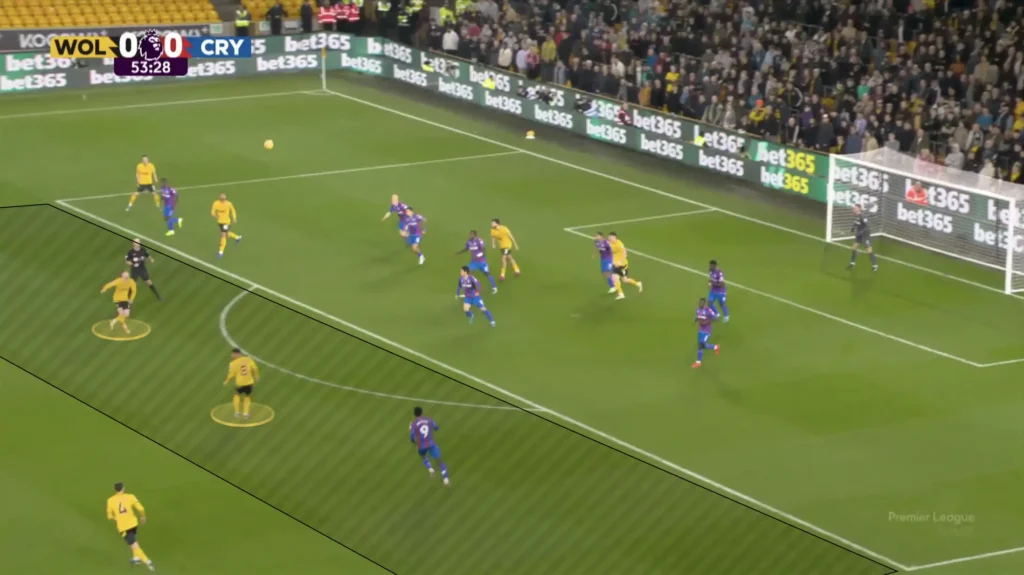
Defending
Low Press
O’Neil’s Wolves uses a 1-5-4-1 formation in the low press. They look to set up in a low-block, always trying to close the center and force the opposition out wide.
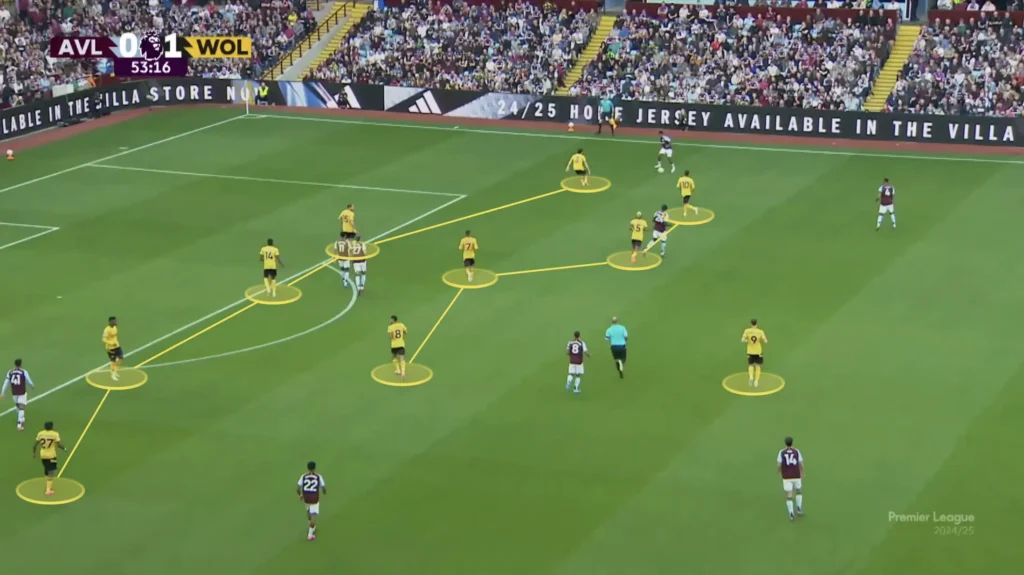
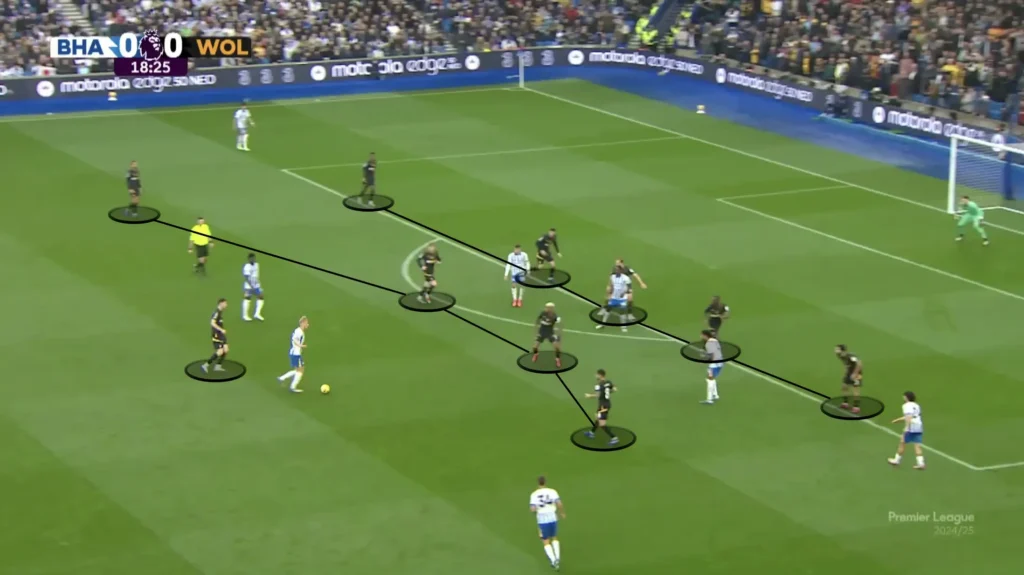
Defending in a 1-5-4-1 formation emphasizes solidity and compactness, making it particularly effective against teams that rely on wide play or quick transitions. The five defenders, including three center-backs and two wing-backs, create a strong defensive line that can absorb pressure and cover the width of the pitch. The four midfielders in front of the backline provide an additional layer of protection, often pressing the ball and cutting off passing lanes, while also helping to maintain the team’s shape. The lone striker remains higher up the field and usually tries to push the opposition to one side. This formation aims to limit the opposition’s space, forcing them to take risks or attempt crosses, which can be more easily defended with the numbers in the box.
Aggressive Center-backs
A notable aspect of Wolves’ low block is their aggressive center-backs. The center-backs are never afraid to push up on an opposition midfielder to stop them from turning and driving with the ball.
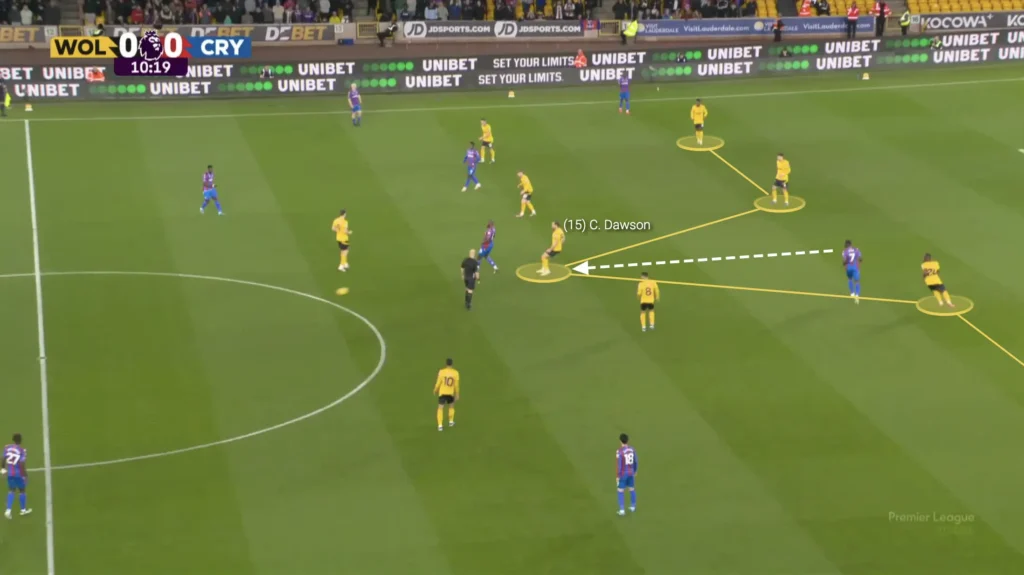
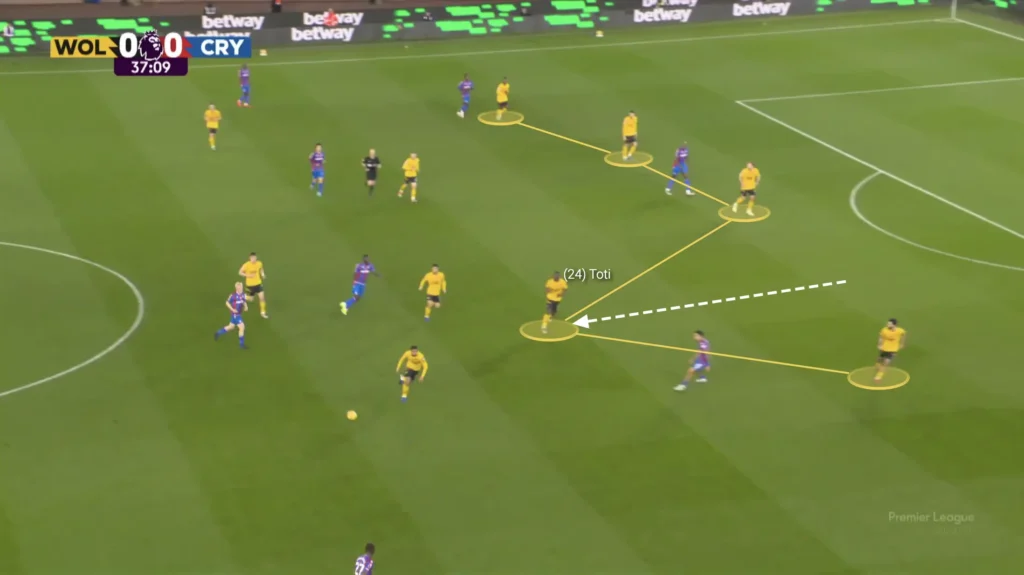
This forces the opposition back while giving the Wolves midfielders and attackers more freedom to push up and press when defending. The problem with pushing up a center-back is that big spaces get created between the defenders. O’Neil’s players are, however, great at solving this. The backline will quickly become a compact back four, with the defenders coming across to close the space that the pushing center-back opened.
Compactness
Gary O’Neil’s Wolves is known for being extremely compact when defending, a hallmark of his tactical philosophy. The team maintains a tight defensive shape, often utilizing the low-block to close down spaces between the lines and limit the opposition’s passing options. O’Neil ensures his players stay close together, reducing gaps for opponents to exploit and making it difficult for them to progress centrally.
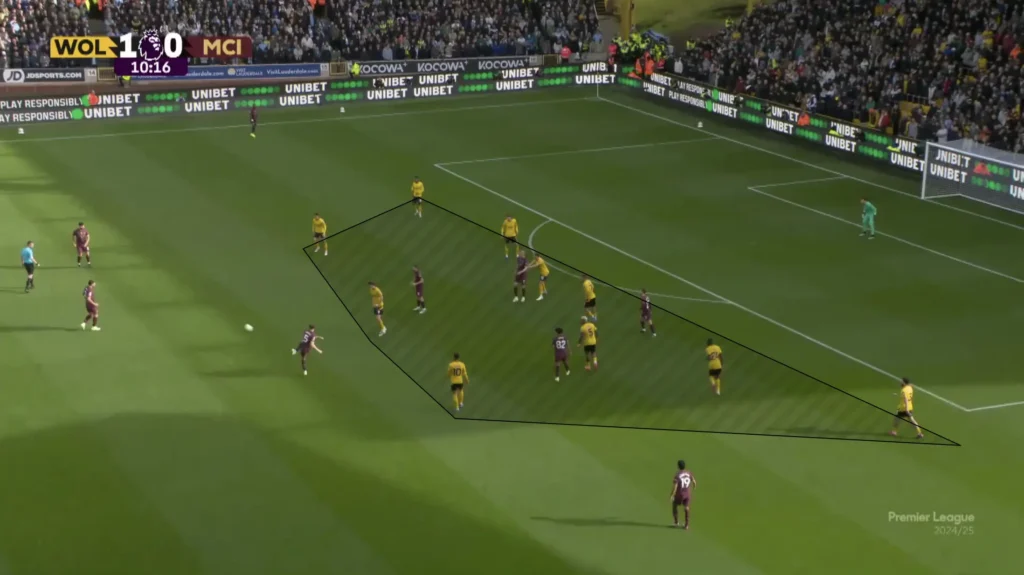
The compact structure allows Wolves to defend in numbers, with players quickly collapsing on the ball when it enters their zone, forcing the opposition to play wide or attempt risky passes. This disciplined approach not only frustrates opponents but also enables quick counterattacks when possession is regained.
Dropping Too Low?
The downside of this is that Wolves sometimes can find themselves dropping too low when defending, which invites sustained pressure from the opposition. In these moments, the backline sits deep, and the midfield and striker compress to protect the space in front of the defense.
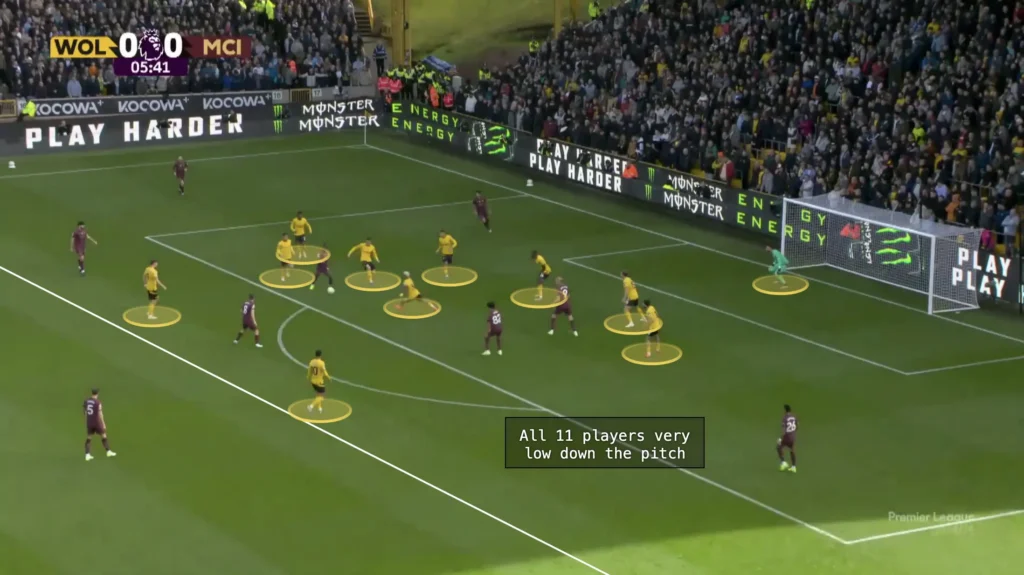
While this compact shape can make it hard for opponents to break through centrally, it often leaves Wolves vulnerable to massive pressure where the opposition can control possession for long periods of the game.
Dropping so deep also limits their ability to transition quickly into attack, as it takes longer to push players upfield once possession is regained. The striker will be too low to compete for any clearances, and if Wolves try to play out, the opposition can simply compress the space and win the ball back. This means the opposition can keep the pressure on, not allowing Wolves to build any counterattacks or momentum, which forces Wolves to constantly defend without threatening the opposition.
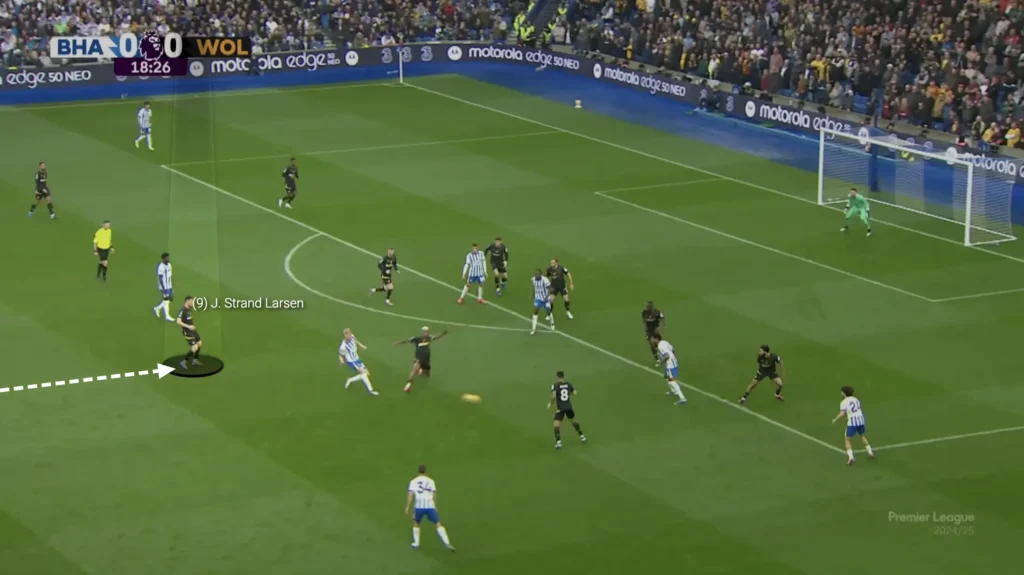
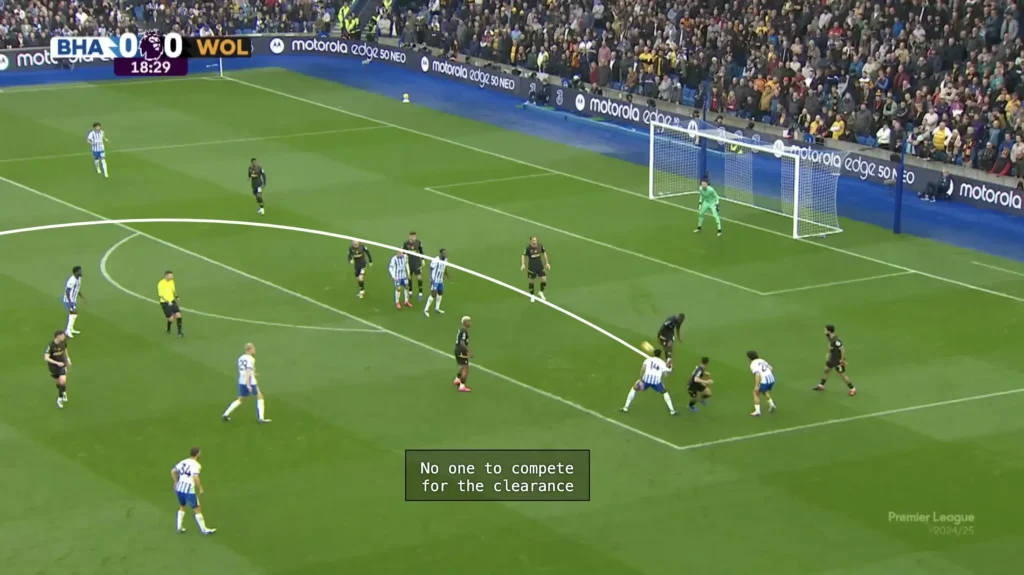
Additionally, when Wolves drop too low in defense, they leave space outside the box, making them susceptible to long shots. Opponents often take advantage of this, finding time and space to attempt powerful strikes from distance. Both Man City and Newcastle were able to take advantage of this by scoring from long shots.
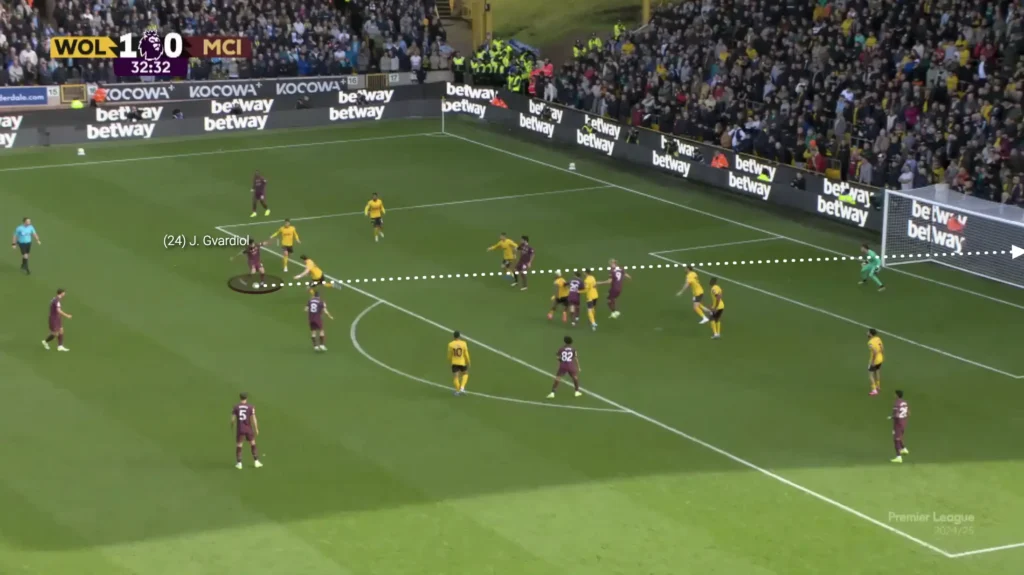
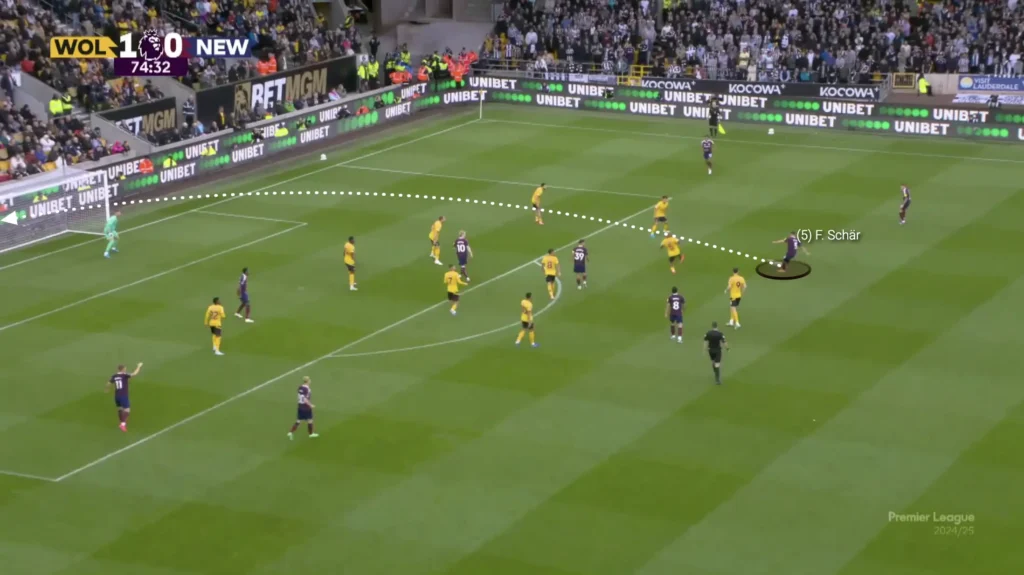
High Press
Wolves under Gary O’Neil often avoid pressing high up the pitch, preferring to stay compact and organized in a mid or low-block. However, in some games, they have applied high pressure, especially when they spot opportunities to disrupt the opposition’s build-up in key areas. Their pressing structure will depend on the opposition, but they primarily press in a 1-4-1-3-2 formation.
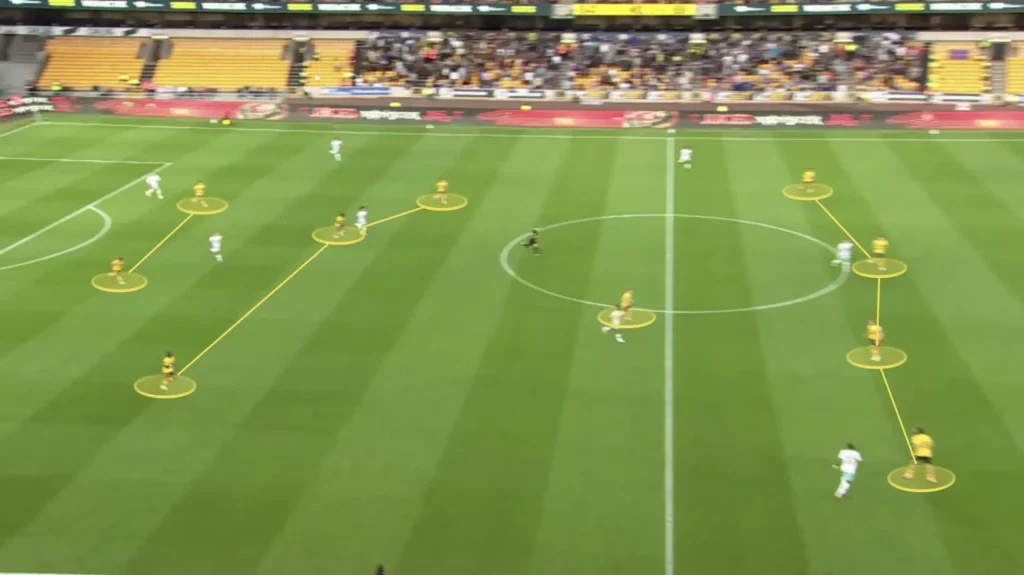
When the play starts, the strikers will try to close off one opposition center-back by making angled pressing runs, forcing the opposition to one side.
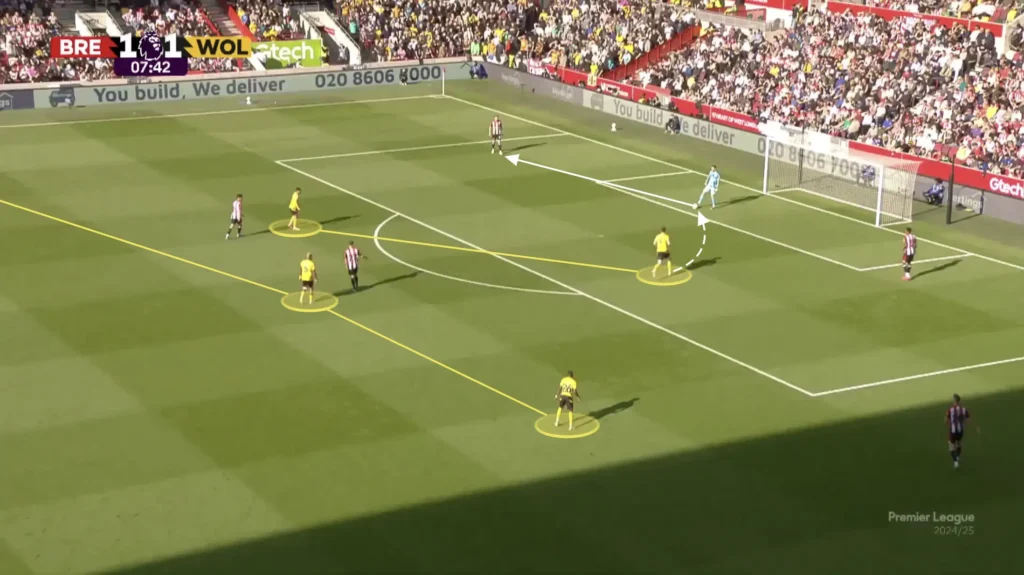
Wolves will be aggressive and intensely press to win the ball when it gets played out to one of the opposition fullbacks. The ball-side wide midfielder will push up on the ball-side fullback, with the rest of the midfield shifting across to close down any passing options.
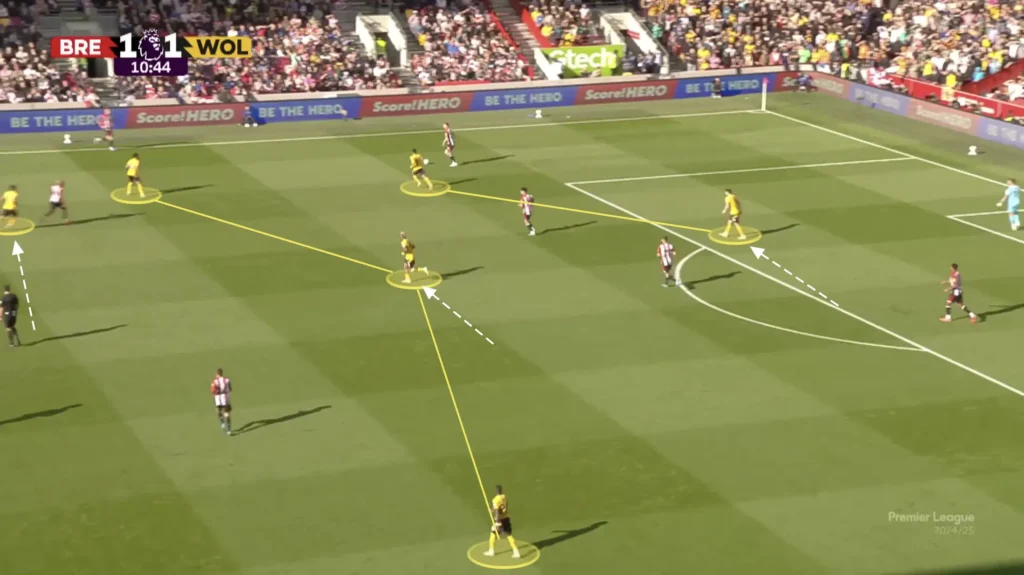
The wide midfielder will press from the inside, closing any passes into the middle. The ball-side striker will try to stop the opposition from switching sides by closing the pass to the ball-side center-back, while the Wolves midfielders, who have shifted across, will push up on the opposition midfielders. This gives the opposition fullback very few passing options and often triggers a rushed long ball. The benefit of this system is that it gives the Wolves backline a numerical advantage against the opposition attackers, which means they usually win the long balls.
Transitions
Defensive Transitions
Wolves are great in defensive transitions. In possession, they always have many players high up and close to the ball, which creates good conditions for counterpressing. Many players close to the ball after losing possession means that many players can work towards regaining possession. O’Neil’s players are also very aggressive in the first seconds after losing the ball. The four or five players closest will immediately jump on the opposition player with the ball and close the distance to cut off any passing lanes. This approach disrupts the opponent’s transition from defense to attack, forcing errors and creating opportunities to regain control in dangerous areas.
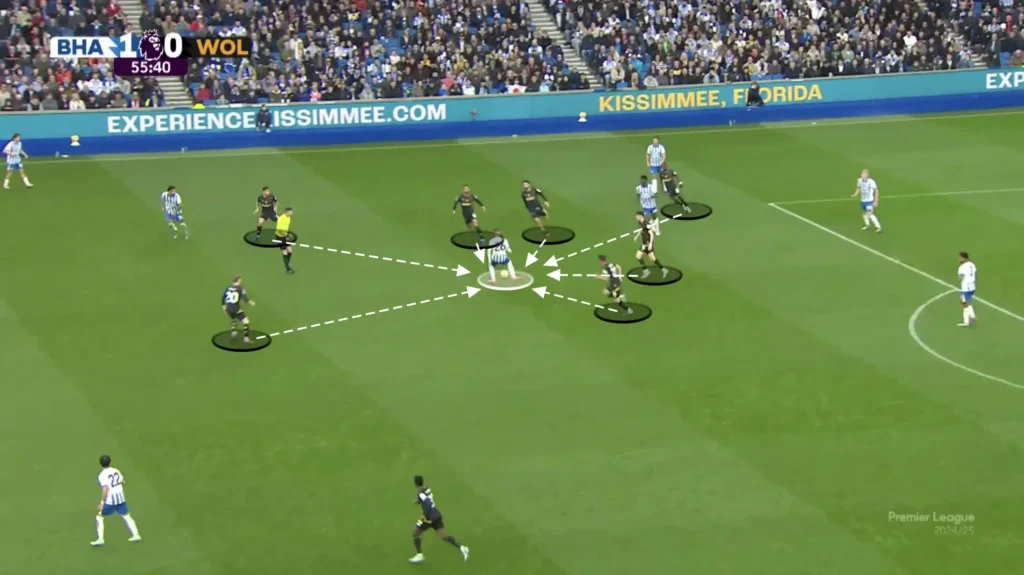
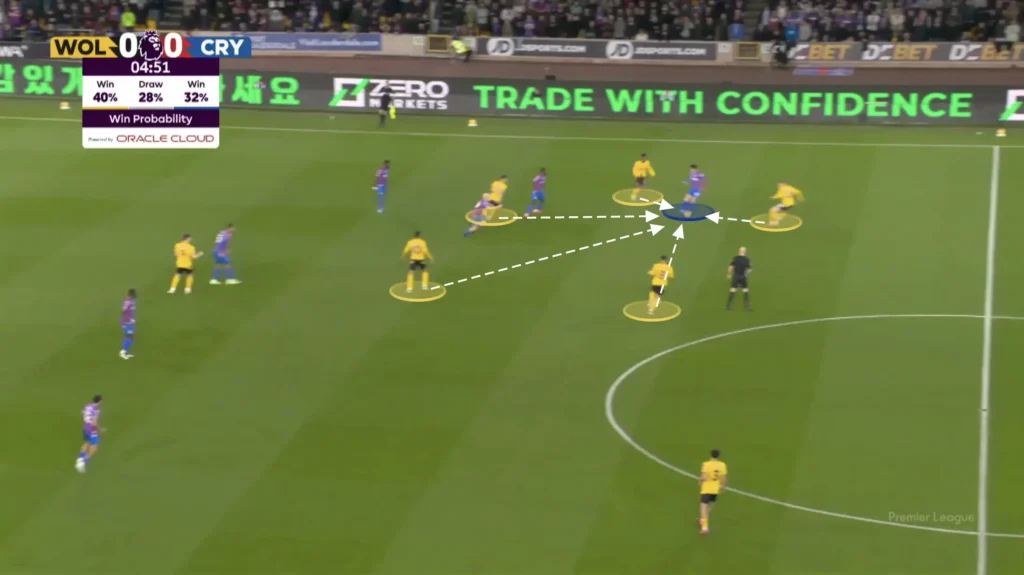
Counterpressing like this keeps Wolves on the front foot, allowing them to dominate possession and create more scoring opportunities. However, it requires exceptional fitness, tactical discipline, and teamwork.
Offensive Transitions
Gary O’Neil also wants his team to counterattack in their offensive transitions. When they regain possession, the team wastes no time in quickly moving the ball upfield, often bypassing the midfield with incisive, forward passes aimed at exploiting open spaces behind the opposition backline.
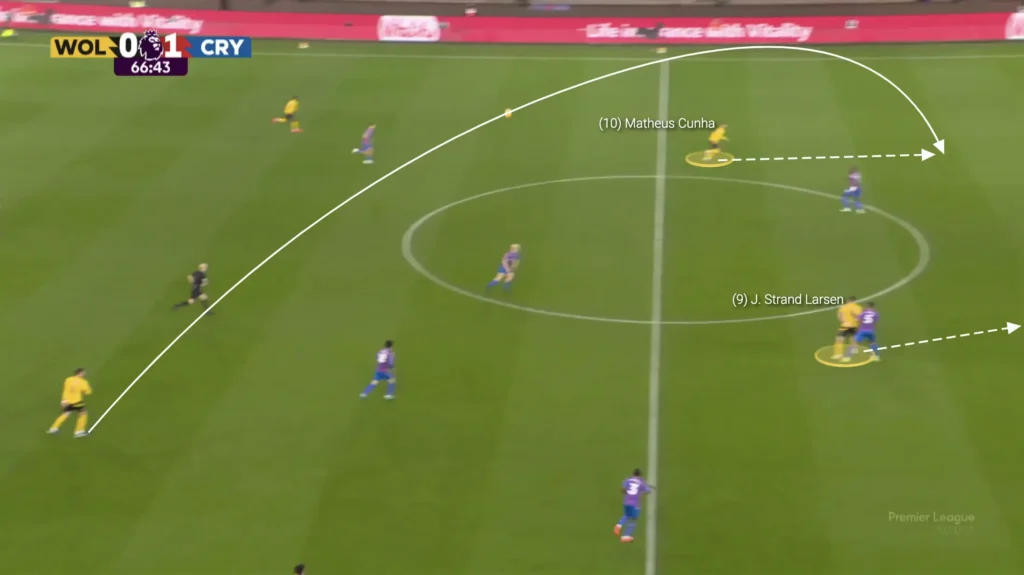
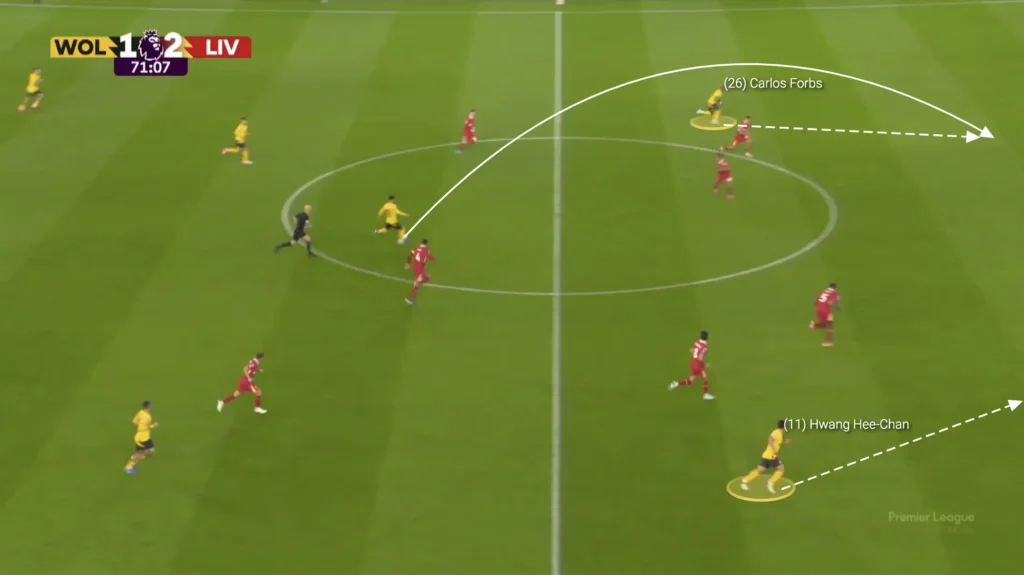
This approach relies heavily on speed and precision, with players like Strand Larsen, Hwang Hee-Chan, and Matheus Cunha driving forward at pace to create immediate pressure on the opponent’s backline. The wide players stretch the pitch, while midfielders push up in support, creating a high-tempo wave of attack. Wolves’ direct style catches many teams off-guard, allowing them to capitalize on defensive disorganization and create high-quality chances before the opposition has time to regroup. This swift, no-nonsense approach has made Wolves dangerous on the break, especially against teams that commit players forward.
Additionally, Wolves try to involve many players in their counterattacks, creating varied options and making it difficult for opponents to predict the next move. The attackers, midfielders, and even wingbacks push forward rapidly to join the attack, ensuring that Wolves have plenty of support around the ball and several passing options in transition.
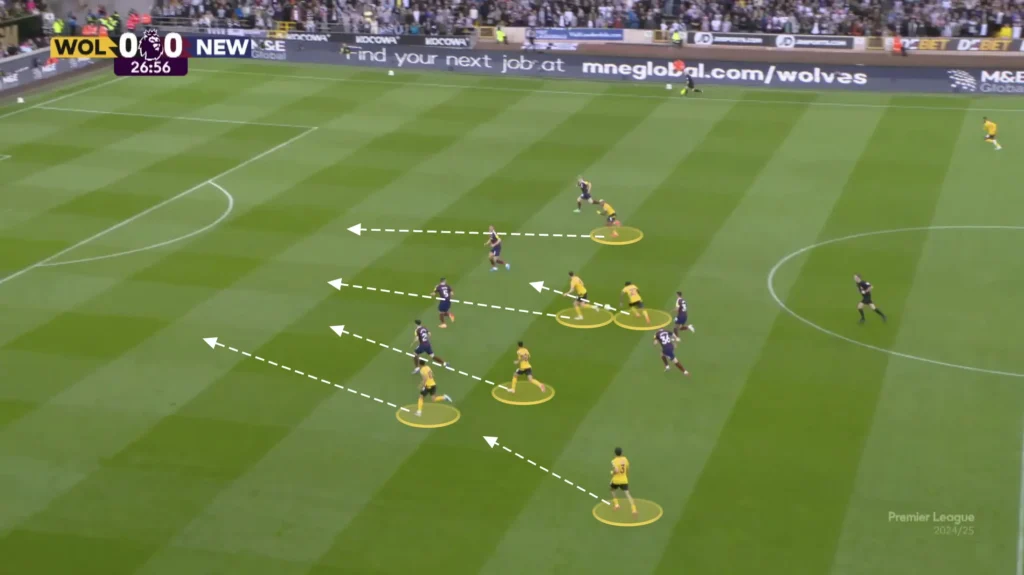
Final Thoughts
In conclusion, Gary O’Neil’s tactical approach at Wolves has introduced a disciplined and pragmatic style that emphasizes organization, adaptability, and smart transitions. His strategies reflect a balanced approach, combining defensive resilience with efficient counterattacking opportunities. O’Neil has shown a clear understanding of how to maximize his players’ strengths, encouraging structured build-ups while keeping Wolves compact and hard to break down.
As Wolves progress under O’Neil’s leadership, the tactical elements we’ve explored underscore his growing influence on the squad. His impact is already evident, with Wolves becoming a team capable of executing well-planned tactics against a range of opponents. O’Neil’s vision for Wolves hints at a promising future, where continued tactical refinement could see them push further up the table with a solid, cohesive game plan.
